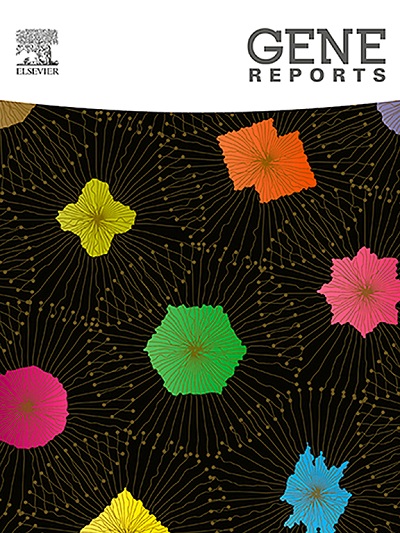Decoding whole genome of an industrially important thermophilic bacterium Anoxybacteroides rupiense
IF 1
Q4 GENETICS & HEREDITY
引用次数: 0
Abstract
Anoxybacteroides (previously Anoxybacillus) is a relatively new genus, proposed in the year 2000, and comprised of many species which are reported to play a vital role in bioprocessing and bioremediation. Very few reports described the whole genome sequence (WGS) of this genus. Therefore, in this study, WGS of a new strain, UE27, was analyzed. This thermophilic strain was previously isolated from the crocodile pond of Manghopir, Karachi. The genome of A. rupiense (previously Anoxybacillus rupiensis) UE27 was submitted to NCBI GenBank with the accession number JBHLFH010000000.1. Genome size was found to be 3,771,980 bp with 76 contigs and 42.33 % GC content. Among 3789 genes, 3708 were found as protein coding genes. Interestingly, intake prophage genome was found which has not been previously reported in A. rupiense. The prophage region contained 68 coding sequence among which 48 were identified as phage-related genes with 40.09 % GC content. The xylan degradation genes were also annotated in the genome. Moreover, many genes responsible for azo dye degradation, heavy metal detoxification and hydrocarbon removal were found in the genome. Conclusively, this study provided insight into gene repertoire of A. rupiense and a basis for the potential application of this thermophilic bacterium in bioremediation and bioprospecting.
解码工业上重要的嗜热细菌红宝石无氧杆菌的全基因组
Anoxybacteroides(以前的Anoxybacillus)是一个相对较新的属,于2000年被提出,由许多种在生物加工和生物修复中发挥重要作用的物种组成。关于该属的全基因组序列(WGS)的报道很少。因此,本研究对新菌株UE27的WGS进行了分析。这种嗜热菌株以前是从卡拉奇Manghopir的鳄鱼池中分离出来的。rupiense(原rupianoxybacillus rupiensis) UE27基因组提交至NCBI GenBank,登录号为jbhlfh0100000001。基因组大小为3,771,980 bp,包含76个contigs, GC含量为42.33%。在3789个基因中,发现3708个为蛋白质编码基因。有趣的是,我们发现了以前没有报道过的吸血原噬菌体基因组。原噬菌体区包含68个编码序列,其中48个为噬菌体相关基因,GC含量为40.09%。木聚糖降解基因也被标注在基因组中。此外,在基因组中还发现了许多与偶氮染料降解、重金属解毒和碳氢化合物去除有关的基因。本研究为深入了解该菌的基因库提供了依据,为该菌在生物修复和生物勘探中的潜在应用奠定了基础。
本文章由计算机程序翻译,如有差异,请以英文原文为准。
求助全文
约1分钟内获得全文
求助全文
来源期刊

Gene Reports
Biochemistry, Genetics and Molecular Biology-Genetics
CiteScore
3.30
自引率
7.70%
发文量
246
审稿时长
49 days
期刊介绍:
Gene Reports publishes papers that focus on the regulation, expression, function and evolution of genes in all biological contexts, including all prokaryotic and eukaryotic organisms, as well as viruses. Gene Reports strives to be a very diverse journal and topics in all fields will be considered for publication. Although not limited to the following, some general topics include: DNA Organization, Replication & Evolution -Focus on genomic DNA (chromosomal organization, comparative genomics, DNA replication, DNA repair, mobile DNA, mitochondrial DNA, chloroplast DNA). Expression & Function - Focus on functional RNAs (microRNAs, tRNAs, rRNAs, mRNA splicing, alternative polyadenylation) Regulation - Focus on processes that mediate gene-read out (epigenetics, chromatin, histone code, transcription, translation, protein degradation). Cell Signaling - Focus on mechanisms that control information flow into the nucleus to control gene expression (kinase and phosphatase pathways controlled by extra-cellular ligands, Wnt, Notch, TGFbeta/BMPs, FGFs, IGFs etc.) Profiling of gene expression and genetic variation - Focus on high throughput approaches (e.g., DeepSeq, ChIP-Seq, Affymetrix microarrays, proteomics) that define gene regulatory circuitry, molecular pathways and protein/protein networks. Genetics - Focus on development in model organisms (e.g., mouse, frog, fruit fly, worm), human genetic variation, population genetics, as well as agricultural and veterinary genetics. Molecular Pathology & Regenerative Medicine - Focus on the deregulation of molecular processes in human diseases and mechanisms supporting regeneration of tissues through pluripotent or multipotent stem cells.
 求助内容:
求助内容: 应助结果提醒方式:
应助结果提醒方式:


